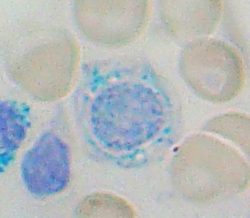Sideroblastic anemia
Sideroblastic (also sideroblastic) anemias are disorders manifested by the finding of ring-shaped sideroblasts in hematopoietic tissue. Sideroblasts are erythrocyte precursors containing a ring formed by mitochondria filled with iron stores, which cannot be used for heme synthesis. We usually divide this disease into two groups: congenital and acquired. We classify it as anemia from a disorder of erythrocyte hemoglobinization, which also includes thalassemia and other hemoglobinopathies.
Sideroblastic anemia:
Sideroblastic anemia 2:
Congenital sideroblastic anemia[edit | edit source]
It is a rare disease with a mutation of the ALAS2 gene, i.e. the gene for delta-aminolevulinic acid synthetase, which is important for heme synthesis. It affects men due to the location of the gene on the X chromosome.
Main symptoms[edit | edit source]
The affected erythrocyte cell population is hypochromic and microcytic, but the erythrocytes produced by normal hematopoiesis are normocytic and normochromic. We find increased iron stores that increase transferrin saturation and serum ferritin values. Ring-shaped sideroblasts are found in the bone marrow.
Treatment[edit | edit source]
This type of anemia can sometimes be treated with pyridoxine at a dose of 200 to 300 mg/day, which is suitable for heme synthesis. Another variant is the administration of a transfusion of erythrocytes.
There is a high risk of iron overload when giving red blood cell transfusions because we are transfusing iron and already have pre-existing increased stores! We cannot exclude iron from the body.
Acquired sideroblastic anemia[edit | edit source]
The most common form of this disease includes refractory anemia with proliferation of annular sideroblasts (RARS) within the myelodysplastic syndrome. The cause of iron accumulation is a mutation in the enzyme system that utilizes iron in the mitochondria. It can rarely occur during treatment with antituberculosis drugs ( isoniazid ) or drugs such as azathioprine. They also occur in lead poisoning, when the enzyme ferrochetalase is inhibited - important for the synthesis of heme and also in rheumatoid arthritis and some tumors.
Summary video[edit | edit source]
<mediaplayer width='500' height='300'>https://www.youtube.com/watch?v=N_hXUkzppLY</mediaplayer>
Links[edit | edit source]
Related Articles[edit | edit source]
Literature[edit | edit source]
- ČEŠKA, Richard. Interna. - edition. 2015. ISBN 9788073878955.
- NEČAS, Emanuel. Patologická fyziologie orgánových systémů : Část I. 2. vydání edition. Universita Karlova v Praze, 2013. 378s pp. ISBN 9788024617114.




